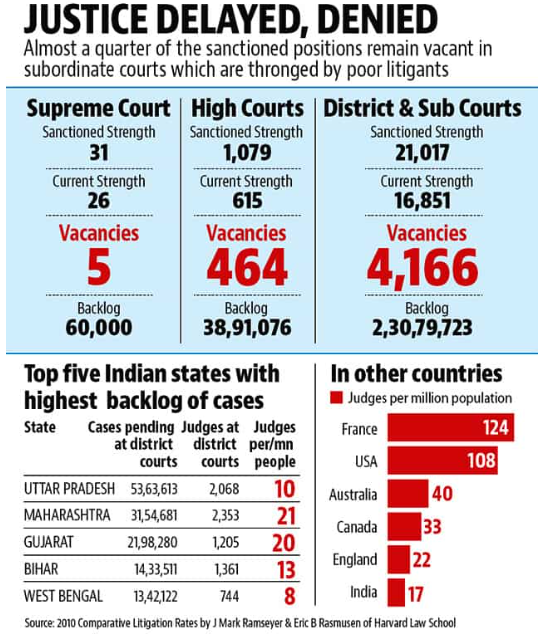End culture of judicial adjournments
Syllabus:
- GS 2: Judiciary
Why in the News?
Recently, President of India Draupadi Murmu at National Conference of District Judges stressed on ending the culture of delayed judgment, saying that the delay in justice had particularly affected rural and underprivileged communities.
Introduction
- President of India, Draupadi Murmu recently emphasized the need to control Judicial suspension of cases, pointing out that delays in settlements particularly affect the poor and rural communities.
- Despite the reforms, the Indian judiciary continues to face significant challenges, from a backlog of cases to understaffed courts, which require immediate attention for effective redressal.
End Judicial Adjournment
- Addressing the National Conference on District Judiciary in New Delhi today, President of India Draupadi Murmu stressed the need to end the culture of judicial adjournments.
- He emphasized that delays in arbitration discourage poor and rural people from seeking justice for fear of lengthy court appearances.
- Since Colonial rule and post-independence period, civil courts handled civil cases under Code of Civil Procedure while criminal courts handled criminal cases in accordance with the Criminal Procedure Code of India.
- In India, Supreme Court and the High Court deals with constitutional matters, are also empowered to issue writs and exercise appellate jurisdiction.
42nd Constitutional Amendment 1976
- Tribunals: To ease the burden on the civil courts, a court system called as Tribunals was introduced to deal with special cases with a fixed settlement period. Special legislation also established forums for timely decision-making.
What hinders timely Resolution?
- Judiciary: Population Ratio: as of 2024, India has 21 judges per million population, far below the 50 judges per million recommended by the Law Commission, creating delay in justice delivery.
- Judicial vacancies: A consistent lack of filling of judicial positions slows resolution, as judges often preside over multiple courts at the same time, including special sessions.
- Impact Analysis: Many laws are enacted without consideration of their judicial impact, increasing backlogs.
- Bringing witnesses to trial/court also delays, extending the trial time.
Rising Pendency of Cases in India
- As of October 2024, only 770 posts have been filled against the sanctioned strength of 1,114 judges in the Supreme Court, leaving the vacancy rate at 30%.
- This drawback affects the ability to handle increasing volume of cases.
- Expanded Jurisdiction of High Court: High courts hear constitutional documents including appeals, amendments, transfers, bail and contempt cases.
- The dissolution of 6 special courts in 2021 added more cases to the Supreme Court, compounding the backlog.
- For these reasons, it usually takes 6 to 7 years for a case to be decided in the higher courts.
Burden on the Supreme Court
- Though the Supreme Court has almost all of its 34 accredited judges, it faces a huge delay.
- About 24 statutes allow for direct appeals with warrant and jurisdiction, giving rise to a broader scope of appeals.
- Common Court of Appeal: Most of the judgments of the High Court, especially those in North India, are appealable under Article 136 of the Constitution which allows an appeal to the Supreme Court, and it gives them greater power.
Stress among judicial authorities
- Workload: From the district to the Supreme Court, judges handle a lot of work. For example, judges are responsible for calls, hearings, sentencing, remand hearings, private complaints, bail and death declaration recording and other duties.
- Additional costs: Assigning additional courtrooms to a judge, especially in complex cases, increases work and mental stress, which can affect concentration, increase errors and has prolonged the matter.
Encourage Mediation
- Mediation provides a process for the parties to resolve a dispute amicably, if both parties agree.
- However, even if one party insists on arbitration, the arbitration cannot proceed smoothly.
Analysis of Judgment Impact
- Justice M Jagannadha Rao Committee Recommendation: committee recommended a “judicial impact analysis” for each new law.
- It proposes that any legislation should set out the likely costs and issues, including courts, judges, bureaucracy and infrastructure.
- Supreme Court endorsed the Recommendations: The Supreme Court endorsed these recommendations in Salem Advocate Bar Association (II) v. United States. Union of India (2005).
Strengthening the judiciary
- Dealing with vacancies: High courts and state governments should jointly initiate the selection of judicial vacancies at least 6 months in advance.
- Judicial focus: Judges do not have to be assigned new charges, allowing them to focus entirely on cases within their jurisdiction to improve efficiency and reduce backlogs.
Conclusion
Systemic reforms are needed to address judicial delays, including appointment of competent judges, compliance with timelines, use of mediation, ensuring timely justice and upholding rights of citizens.
Source: The Hindu
Mains Practice Question:
Discuss the challenges faced by the judiciary in reducing judicial adjournments, focusing on procedural and administrative issues. What role do judicial vacancies play in this regard?




